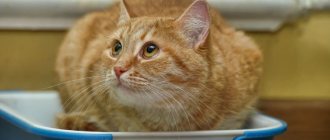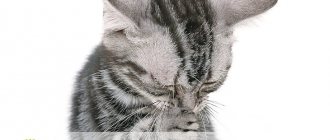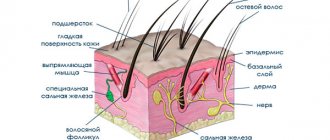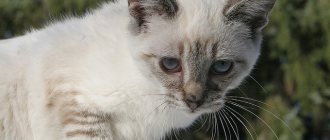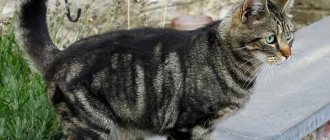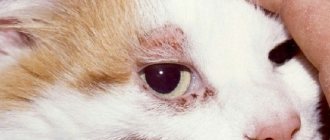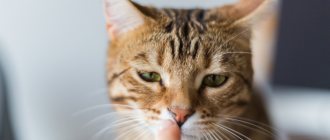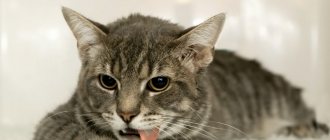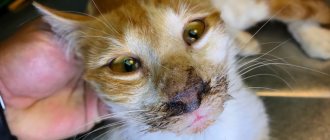In general, cats have many things that make people fall in love with them: soft paws, majestic whiskers and, of course, fluffy fur. This is why it can be frustrating to watch your cat continually shed hair at the base of her tail day after day. Without treatment, hair loss around the tail in cats often results in localized hair loss, which leaves the cat's coat in an unsightly condition. If you want to put an end to hair loss, you must identify the root cause and treat it as soon as possible.
Need help with your cat's tail hair loss problem? Then this article will really be useful to you. Below, you'll learn just about everything pet owners need to remember about cat hair loss, from causes to solutions. Use the following information you get here to help your kitten get his fur back.
Causes of tail hair loss
To stop your cat's tail hair loss, you need to know what causes it. Although different cats experience different troubles, keep these suspects in mind as you analyze the situation.
© shutterstock
- Allergies . Just like humans, cats also suffer allergic reactions when they come into contact with certain substances in the home. Affected felines often try to bite the tail and pull out tufts of fur until the allergens disappear. Luckily, if your cat is losing tail hair due to allergies, all you have to do is remove the allergens to solve the hair loss problem. Monitor your cat to determine what is causing her allergic reactions. For example, if certain types of food are allergens, pets will vomit shortly after eating.
- Cat caudal gland hyperplasia . Feline tail gland hyperplasia, also known as “hairpin,” is the result of dysfunction of the sebaceous glands, which leads to the accumulation of a waxy, oily substance around the tail. The condition is typically characterized by a foul odor, tiny red dots (caused by a bacterial infection), and hair loss. Feline tail gland hyperplasia is often found in cats and cats that do not maintain hygiene. In most cases, cat parents can solve this problem by simply bathing and grooming them periodically.
- Parasites (fleas, ticks). In general, external parasites are usually not too concerned about location once they have managed to capture a host. At the same time, annoying bloodsuckers can accidentally gather at the base of the tail and cause trouble for the cat. Because the tiny parasites bite pets' skin for blood, they cause minor rashes, dry skin and itching. If your furball scratches his skin to relieve the itching, he will accidentally pull out a lot of hair. To properly address the problem of hair loss caused by parasites, you need to get rid of the parasite and treat the bites.
- Pain . If felines feel pain in a certain area, they will lick that area to calm themselves down. Because of this, cats with arthritis often lick their sore joints. While licking does calm felines, it also removes a lot of fur. So if you notice that your cat is losing hair at the base of its tail, you should definitely consider inspecting the area for signs of injury. If you see sores, bruises, etc. right around your cat's tail, she is probably losing her fur due to pain.
- Stress, anxiety and fear . Regular cats, being sensitive creatures, tend to be frightened by changes in the home. Strange faces, new pets, rearranged furniture... many things can send your furry friend into a panic. When cats feel deathly scared, they use various means to relax: running, hiding, grooming... Most cats will return to their normal state after a while, but if they continue to feel fear, hair loss will occur. To put an end to hair loss caused by stress, anxiety and fear, it is important to help pets calm down.
© shutterstock
Why is this happening?
Among the causes of baldness are:
- Lichen. Typical signs of lichen: peeling of the tail, parts of the hind legs, back and ears. An accurate diagnosis can only be made in laboratory conditions. The affected areas are illuminated with a Wood's lamp. If the fur takes on a greenish tint, treatment for shingles infection is prescribed.
- Hormonal imbalances . The cat's body secretes a special substance from the upper part of the tail. The pet distributes lubricant throughout the body while washing. Too active secretion leads to the fact that the tail peels off and becomes fat.
- Ticks and fleas . Even a domestic cat can become infected with fleas. Ticks are brought in from the street by other residents of the house. The area of the mane and tail is a favorite place for parasites, after which the cat begins to constantly itch and literally tear out the fur.
- Infection with helminths . These are parasites that form in the body. Helminths are transmitted through raw fish and meat. This leads to the cat having a loose tail, and worms become a related problem.
- Bacteria . Typical for cats that periodically go outside. Untreated wounds on the tail are a target for bacteria, which can lead to critical infection and a threat to life.
- Allergy . If your cat's tail is going bald, it could be a response to an allergy. Among the reasons: poor nutrition, cheap food, intoxication with medications. In addition, some cats react painfully to odors, particularly tobacco smoke.
- Stress . As in the case of the appearance of worms, the tail peels off during strong emotional experiences. In older cats, this is a consequence of the appearance of a new pet - a dog or kitten. In young furry animals, stress manifests itself after major home renovations, childbirth, or moving to a new place.
- Inflammation of the glands of the paraanal type . The animal begins to urinate past the tray, and the fact of irritation is confirmed by a shaking tail, which gradually becomes greasy, peels off and loses its fur.
© shutterstock
What to do
Technically, average pet owners can fix the problem of hair loss at the base of their cat's tail themselves. However, if you want to be on the safe side, it is highly recommended that you take your furball to the vets for a thorough examination. Veterinarians will carefully examine your cat and may run some tests to see what's going on and then develop an appropriate treatment regimen. Obviously, people should refrain from medicating cats without prior approval from veterinarians.
Clinics you can go to
The presented veterinary clinics have specialized dermatologists on their staff.
Moscow:
- White Fang. Well-known network of veterinary clinics.
- Medvet. It has high-quality equipment and specialists.
- Your doctor. The dermatology department successfully deals with skin diseases.
Saint Petersburg:
- Kotonai. A network of veterinary clinics in Russia.
- Vega. There is a call service and a discount system.
- Cityvet. Network of veterinary clinics. There are many highly specialized, friendly doctors.
Top 3 Frequently Asked Questions about Hair Loss
- Is it normal for a cat to lose hair?
Well, cats do lose hair from time to time, but many cat experts believe that due to genetics, some breeds lose more hair than others. In most cases, natural hair loss in cats involves a small amount of hair and goes away automatically over time without requiring outside help.
- What is acquired hair loss?
In addition to natural hair loss, cats also experience acquired hair loss, which is a symptom of a condition rather than the disease itself. Once the underlying problem is resolved, acquired hair loss will likely disappear in no time.
- Will my cat's hair grow back over time?
Fortunately, if the cause of the hair loss is treated properly, your cat's hair should grow back just like before. However, to ensure hair grows smoothly, you need to act decisively as soon as you first notice that your cat is losing hair at the tail. All in all, a trip to your local veterinary clinic is always a safe bet if you feel like something is wrong with your kitten.
Diagnosis and treatment
If hair comes off the tail, your four-legged pet should be taken to the vet immediately. At home, without laboratory instruments and professional skills, it is impossible to make an accurate diagnosis and develop a recovery program.
At the veterinary clinic, specialists interview the animal’s owner, study the history of diseases, take a blood test and organize a special study to identify hormonal imbalances. A scraping and ultrasound are performed, which helps determine why the fur is peeling off and whether there are critical disorders in the body.
Treatment methods include the following:
- Prescription of vitamins . Vitamin complexes will help older cats and pets born in a weak state not to go bald. It is suggested to take immunomodulators and sulfur preparations, due to which the tail peels off less and is restored.
- Recovery from allergies occurs in several ways . The basis is a balanced diet: treats are excluded from the diet, and the base is made up of special medicinal food from branded manufacturers. In case of an allergic reaction, taking antihistamines and anti-inflammatory drugs is prohibited. If the pathogen is another pet or smell, the cat is isolated from the allergen.
- The effectiveness of the fight against lichen depends on the timely initiation of treatment . If a cat has a tumor on its tail, vaccines are given in the first stages. Skin affected by dermatitis is treated with antibiotics and antifungal substances, namely intraconazole, griseofulfin.
- When the tail becomes bald at the base after an attack by fleas and ticks, special shampoos help. The products contain fipronil, a component that destroys the environment for the development of parasites and destroys adult parasites and laid eggs. Other methods are sprays and drops that are applied to the scruff of the neck, which provides a comprehensive effect on the entire body.
- The most difficult part is treating the lower part of the tail that is peeling off. In most cases, the disease is associated with inflammation of the anal glands, and this is a disease that is life-threatening for a furry pet. Veterinarians prescribe an ointment that is applied daily, and antibiotics are prescribed as accompanying medications.
- You can prevent negative consequences after open wounds with hydrogen peroxide. Large scratches and cuts larger than a penny are stitched up in the clinic. Amoxicillin, a universal antibiotic, helps fight the infection.
© shutterstock
Endocrine disorders and inflammation of the sebaceous glands
In some cases, a wound on a cat's tail appears due to an imbalance of hormones and endocrine disorders. This is accompanied by systemic disorders - alopecia, obesity, loss of appetite, changes in the behavior of the pet.
Among the dangerous pathologies that provoke the appearance of such a symptom, it is worth highlighting diabetes mellitus. This disease is often diagnosed in obese animals, and develops against the background of impaired carbohydrate metabolism in the pet’s body. One of the specific symptoms of this disease are deep, non-healing wounds and weeping erosions on the animal’s tail. The localization of wounds is associated with the specifics of blood circulation in this area.
Another common cause of erosion is blockage and inflammation of the sebaceous glands. Pathology also refers to endocrine disorders and requires consultation with a specialist. It is not advisable to treat wounds on your own, without specific treatment for the underlying disease, since after a while they will appear again.
As a rule, treatment of endocrine disorders begins with adjusting the animal’s diet. This is followed by drug therapy, including hormonal therapy.
Vitamin deficiency as a cause of alopecia
Quite often, a pregnant cat becomes bald near the tail. In this case, we are talking about a lack of nutrients - vitamins and microelements. A cat bearing kittens needs a special diet, taking into account the changing needs of the body. Alopecia in pregnant animals should be treated by changing their diet. If the cat's diet consists of natural food, it should be supplemented with special fortified supplements. Dry food during pregnancy must be replaced with special products intended for pregnant cats. Such foods are distinguished by a large amount of vitamins and microelements that cover the body’s need for these substances.
We recommend the article: Should I worry if my cat's whiskers fall out?
Vitamin deficiency also affects small kittens and older animals. This problem occurs especially often in kittens taken from the street. Due to the lack of normal nutrition, the immunity of animals weakens, against which a number of diseases develop, including hair loss. In all cases, you can get rid of the symptom only by adjusting your diet.
You should consult your veterinarian about the need to administer special supplements to older animals (over 7 years old). The fact is that at this age, alopecia may be a consequence of systemic disorders that need to be identified and, if possible, corrected.
How to treat baldness
Amoxicillin is usually prescribed for treatment
After establishing an accurate diagnosis, the doctor will prescribe appropriate treatment. It is aimed at eliminating the symptoms of baldness and combating the primary disease. In case of an allergic reaction, avoid contact of the cat with the allergen and give the animal medications that strengthen the immune system. For food allergies, a special diet is prescribed (Purina HA, HillsZD and others).
If the skin is damaged by parasites, the cat is treated with medications for fleas and other blood-sucking creatures (sprays, drops and shampoos with fipronil or other active substances that cause paralysis and death in parasites are used) and vitamins and immunostimulants are included in the diet.
Skin infections are treated with a course of antibiotics, usually amoxicillin is prescribed for this purpose. Demodectic mange in cats is combated with regular baths with sulfur-selenium shampoo 1%. If baldness is caused by severe stress, the animal is prescribed sedatives.
For ringworm, the hair is shaved off and the cat is given the following medications:
- itraconazole;
- ketoconazole;
- griseofulfin - it is better to feed this drug with a piece of butter, so it will be better calmed down.
When should you sound the alarm?
Reasons why a cat lowers its tail:
- A strong blow or fracture can cause the cat to not raise its tail.
- Damage to nerve endings is also a possible problem. It is impossible to start treatment, since this organ is an extension of the spine and its integrity is necessary for full-fledged work.
- Stroke - if the animal is of advanced age, this will cause the cat’s tail to hang. In this case, the veterinarian will prescribe antibiotics that will return the tail to its normal position in whole or in part. But relapse can happen again.
- Nerve problems - living in stressful conditions. For example, if a cat is oppressed, often beaten, or he is simply not yet accustomed to new owners who have just adopted a new four-legged friend, then he will behave nervously. At such moments, you should not rush to establish a connection with the cat, because good relationships are formed over time, when the animal gets used to the new environment.
- Safety of your offspring. It’s not uncommon for cats to want to protect kittens from exposure to humans or other dangers. This often happens if a pregnant cat does not have her own secluded place where she can safely give birth and raise her offspring. Until the time comes, she will walk from corner to corner with her tail lowered, and look for a suitable option.
- Hereditary predisposition. Often, after crossing different breeds, kittens with deformities are born. Most often, such a developmental deviation does not cause discomfort.
- If the animal is tired, then this position will be a characteristic feature. In this case, the cat needs to be allowed to sleep and rest.
Almost all symptoms will be accompanied by a lack of appetite and unusual behavior.
Causes of severe baldness
Baldness is easy to notice at the initial stage, as the cat leaves hairballs everywhere and bald patches appear on the skin. The ears, tail and abdominal area are most often affected. Baldness - alopecia, indicates a serious malfunction in the functioning of the body itself, but is not an initial disease and is divided into three main groups:
- allergic;
- infectious (parasitic);
- endocrine (hormonal disorders).
Based on the condition of the skin itself in areas of severe baldness, the cause of the appearance and development of alopecia is determined. In frequent cases, bald areas may show severe redness, a rash, and the skin in these areas itches, tormenting the pet. With more serious diseases, ulcers and scabs may form, the cat scratches the affected areas vigorously, and the skin in these areas loses its elasticity and becomes hot to the touch.
Tail injuries and their consequences
If a cat falls from a height or accidentally gets run over by a car or even a person's feet with its tail, injury to this organ can lead to serious consequences.
At the slightest suspicion of injury in a kitten or an adult whose tail has darkened after a blow, you need to give the animal an x-ray , because with a severe fracture, tissue necrosis can begin, which cannot be cured with simple medications. The doctor may prescribe wearing a splint or plaster cast. After treatment, a re-examination with x-rays is carried out.
Baldness in cats, how to deal with shedding: advice from a veterinarian
Seasonal shedding is normal. This period is especially noticeable for owners of long-haired pets. Molting can last from 2 weeks to 3 months. Veterinarians advise washing and combing animals more often during this time.
Be sure to read:
Why does a cat constantly scratch its chin: what kind of disease is it?
Effective shampoos against hair loss:
- "Phytoelite" from "Veda";
- SynergyLabs Shed-X Cat;
- Perfect Coat 8 in 1.
It is useful to take vitamin complexes, preferably in liquid form.
Bald spots in cats caused by hereditary causes cannot be treated.
To remove hair from the stomach, it is recommended to give special medications:
- Pet Naturals of Vermont;
- Actipet;
- Vaseline oil, etc.
Ordinary grass can help get rid of lumps; in the summer, it is enough for the animal to go for a walk; in winter, the seeds can be purchased at pet stores and planted yourself.
If shedding is accompanied by specific signs, it is necessary to show the cat to a doctor.
Why does a cat go bald: reasons
Baldness (alopecia) leads to the appearance of bare patches of skin on your pet's body.
If there is too much hair, bald spots appear, the animal behaves restlessly
The main reasons for the development of pathology:
- allergic reaction;
- damage by fleas, lice;
- the presence of a scabies parasite;
- otodectosis (ear mites);
- fungal or lichen infections (dermatomycosis, dermatophytosis);
- pyoderma;
- purulent formations on the skin;
- oily seborrhea;
- deficiency or excess of thyroid hormones;
- increased work of the adrenal glands;
- diabetes;
- genetic predisposition;
- stress;
- lack of vitamins;
- chronic diseases of internal organs.
Causes of severe baldness
Baldness is easy to notice at the initial stage, as the cat leaves hairballs everywhere and bald patches appear on the skin. The ears, tail and abdominal area are most often affected.
Baldness (alopecia) indicates a serious malfunction in the functioning of the body itself, but is not an initial disease and is divided into three main groups:
- Allergic;
- Infectious (parasitic);
- Endocrine (hormonal disorders).
Based on the condition of the skin itself in areas of severe baldness, the cause of the appearance and development of alopecia is determined. In frequent cases, bald areas may show severe redness, a rash, and the skin in these areas itches, tormenting the pet.
With more serious diseases, ulcers and scabs may form, the cat scratches the affected areas vigorously, and the skin in these areas loses its elasticity and becomes hot to the touch.
Oncological diseases
Cancer tumors cause many negative processes in a living organism. The tumor grows rapidly, robbing the body of nutrients, blocking the blood flow at its location, disrupting the functioning of the body, so hair loss is a fairly common symptom of oncology. The most dangerous pathology in which a cat goes bald is skin cancer. You can suspect your pet has a terrible disease based on the following symptoms:
- enlarged lymph nodes;
- sudden weight loss;
- strongly noticeable unpleasant odor from the mouth;
- purulent discharge from any part of the body;
- loss of appetite;
- dyspnea;
- non-healing wounds or ulcers.
Oncological diseases are treated primarily surgically; after surgery, the animal undergoes a course of chemotherapy. If hair falls out between the hind legs, back, belly or face, there is no need to worry: this is a natural reaction of the body to anti-cancer drugs.
